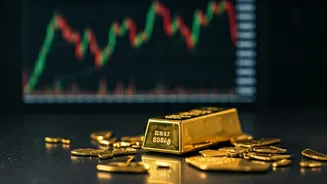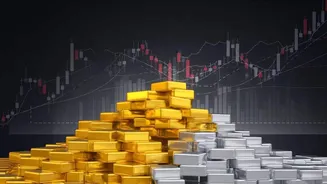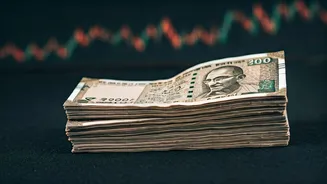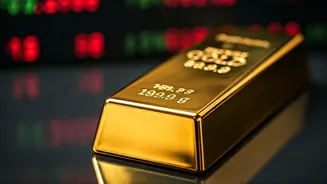The Precipitous Fall
Gold prices recently experienced a substantial downturn, plummeting over 5% in a single day, an event representing the most significant decrease since
2013. This abrupt decline triggered a wave of reactions from investors and market analysts alike. The downward trend wasn't limited to gold; silver also saw a sharp decrease, with prices dropping by 7%. This dual fall in precious metals indicates a broader shift in the market dynamics. Understanding the root causes of this precipitous drop is vital for anyone involved or interested in the financial markets, offering critical insights into the forces that shape investment decisions.
Causes of the Drop
Several factors combined to create the conditions for this sharp decline in gold prices. A strengthened US dollar played a key role, making gold more expensive for holders of other currencies, which reduced demand. Furthermore, rising interest rates, especially in the US, made alternative investments like bonds more attractive, as these offered higher returns. The expectation of increased interest rates often encourages investors to move away from gold, which yields no interest. Additionally, shifts in global economic outlook, including adjustments in inflation expectations and investor sentiment about market stability, also impacted the price movement. These combined elements created a perfect storm, pushing gold prices down dramatically.
Market Reactions
The price plunge generated a flurry of activity in financial markets. Investors reacted swiftly, with many re-evaluating their portfolios. Some chose to sell gold holdings, contributing to the downward pressure on prices, while others looked for opportunities to buy at lower prices, anticipating a potential rebound. Market analysts closely monitored these movements, providing constant updates and opinions. The immediate impact was felt across various financial products, including gold-backed ETFs and related financial instruments. The volatility showcased the sensitivity of the gold market to various economic and geopolitical events. Media outlets and financial platforms were filled with analyses and commentary, as everyone attempted to understand the drop and its implications.
Future Forecast
Forecasting the future trajectory of gold prices is inherently complex. Analysts offer varying perspectives, depending on their view of the market. Some predict a possible rebound, citing historical patterns where gold prices have recovered after substantial drops. This recovery might hinge on factors like a weakening dollar, a shift in interest rate policies, or increased geopolitical uncertainty, which often drives investors toward safe-haven assets like gold. Conversely, other analysts suggest that gold prices might face further declines. This could result from continued strength in the dollar, sustained high-interest rates, or greater stability in global economic conditions. The overall consensus is that the future course of gold prices will hinge on a mix of several factors, making it challenging to make precise predictions.
Silver's Performance
Silver, often considered a sister metal to gold, also saw a substantial price decrease during the same period. The drop in silver prices mirrored the trends in gold, suggesting a broader market adjustment. The reasons for silver's decline include similar influences, such as the strengthening dollar, rising interest rates, and changes in investor sentiment. Silver's price movement is additionally influenced by its industrial uses, making it susceptible to shifts in manufacturing demand. Investors frequently watch the gold-silver ratio to understand the valuation relationship between the two metals, using this ratio to make investment decisions. The synchronized decline underscores the interconnectedness of precious metals in the global market.
Long-Term Considerations
Considering the long-term perspective is crucial for understanding the recent gold price drop. Historically, gold has served as a safe-haven asset during times of economic uncertainty and geopolitical turmoil. Many investors incorporate gold into their portfolios to hedge against inflation and economic instability. The long-term performance of gold has varied, with periods of significant gains and periods of consolidation or decline. When looking at the larger economic picture, elements such as global debt levels, inflation rates, and the strength of the dollar impact gold prices over time. Investors with a long-term strategy typically weigh these factors, seeking to make informed decisions about whether to add gold to their investments.
Impact on India
The fluctuations in gold prices have implications for the Indian economy and its citizens. India is a significant consumer of gold, with a strong cultural demand. Changes in international gold prices directly affect the domestic market, influencing retail prices and consumer behavior. The value of the rupee relative to the US dollar plays a significant part in the prices, as fluctuations in the exchange rate can amplify the impact of international changes. Import duties and taxes also have a role in the cost of gold for Indian consumers. When international gold prices drop, there may be an increase in demand from Indian buyers, viewing this as an opportune moment. This dynamic affects both the financial market and cultural practices, highlighting the interconnectedness of global and local economics.
















